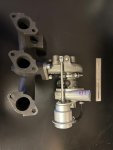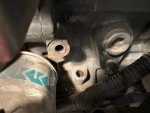DISCLAIMER:
The information contained in the following pages is intended for general information purposes only.
Original poster assumes no responsibility for errors or omissions in the content of these posts, and in no event will be held responsible for any direct, indirect, consequential, or incidental damages to physical or mental health of the reader or any devices or machinery owned by said reader. OP reserves the right to make additions, deletions, or modifications to the contents on these posts at any time without prior notice. Reader assumes full responsibility for any damages to referred equipment and relieves poster from all risk. Thanks, and have a pleasant tomorrow.
************************************************************************************************************************************
Hello and welcome to the thread. Like a number of people on here, I am a fairly recent tractor owner. I have been learning lots of new things (good and bad) about tractor ownership, operation, modification, and maintenance. It's been an interesting ride so far and it looks like it's going to get even more interesting in the next few months. . .
A little history: I'll keep this short, but it provides information for the motive to jump into the abyss of adding a turbocharger to my B2650 tractor.
Several years ago, I built a retirement home up in the Rocky Mountains on the western side of the range. Knowing that I was going to be clearing A LOT of snow in the winters, I found and purchased a low-hour Kubota B2650 with a cab on it. Perfect. Had the dealer put on a B2782 snow blower and had it making white rooster tails in the winter of 2021/2022.
That winter was relatively mild for the area, and the machine worked Okay for the task, but I new immediately that it was struggling to make power. As many of you probably already know, you loose ~3% of your horse power for every 1000 feet of elevation. Here's the kicker: I'm at just under 8000 feet! Yup, 24% of my horse power was GONE before I even turned the key. My 25 horse engine was now making about 19 horse power. Ouch.
This past winter was completely different. We had one of the heaviest, longest winters on record. We were constantly out blowing my 150' driveway and parking area. The machine would do it, but you had to back off forward speed and let it work much slower. All the while, there was almost always some amount of black smoke coming out of the exhaust. For the diesel gurus out there, you already know that black smoke is an indicator of partially burned fuel. The insidious part of this condition is the undesirable rise in exhaust gas temperatures that come along with it. Late in the winter I purchased and installed an EGT sensor and gauge to monitor the exhaust gas temps. When idling or just driving around, temps stayed relatively low, around 350 to 500 degrees (F). But when I dropped the blower and started getting serious, temps would start going up dramatically. Depending on the load, I would see an average of around 600 to 800 degrees, with spikes up to 900 and even 1000 degrees. Researching maximum allowable temps on the internet did not reveal an exact safety zone, however, a general consensus of users agree that transient temperatures between 1200 and 1300(F) in a diesel engine is acceptable, however, a maximum "sustained" temperature should never exceed 1200 degrees (F). This is obviously an arguable point, but at least gave me a starting point for safe operation.
I spent a lot of hours trying to find any information I could on installing an aftermarket turbo on ANY Kubota tractor, let alone the specifics on a B2650. I had all but resigned myself to being one of the first to actually undertake this project alone. Then, just before giving up, I must have entered just the right keywords in my browser and landed on a thread in this forum by "Mike" aka "Rdrcr", detailing the design and installation of a turbo in his Kubota tractor! HALELUYA! I felt like I had just won the lottery. If you haven't already, go read the thread: "L2501 Turbo: A Journey Defined - The tractor, The comparison, The modification, The results. . .". It is an amazing read with incredible details on his own journey on undertaking the arduous task of adding a turbo to his tractor. He is building pieces of art and spared no cost in the process. Those who purchase a kit from him will have the best of the best. I have to give credit to him for giving me the confidence to start my own thread on the subject, and he is still very generous with his help and knowledge to this day. Thanks Mike!
With that being said, my approach will be more like "garage rat". I want to challenge myself to see how inexpensively (?! LOL) I can make this mod and still use good materials and techniques. I won't cut corners, but it might not look as cool. As long as I can at least recover the six horse power I'm loosing from altitude sickness, I'll be happy. Anything above that and I'll be ecstatic.
Whew! Okay kids, now that we got that out of the way, buckle up, rev up the throttle, and let's start this journey. . .
Solo
The information contained in the following pages is intended for general information purposes only.
Original poster assumes no responsibility for errors or omissions in the content of these posts, and in no event will be held responsible for any direct, indirect, consequential, or incidental damages to physical or mental health of the reader or any devices or machinery owned by said reader. OP reserves the right to make additions, deletions, or modifications to the contents on these posts at any time without prior notice. Reader assumes full responsibility for any damages to referred equipment and relieves poster from all risk. Thanks, and have a pleasant tomorrow.
************************************************************************************************************************************
Hello and welcome to the thread. Like a number of people on here, I am a fairly recent tractor owner. I have been learning lots of new things (good and bad) about tractor ownership, operation, modification, and maintenance. It's been an interesting ride so far and it looks like it's going to get even more interesting in the next few months. . .
A little history: I'll keep this short, but it provides information for the motive to jump into the abyss of adding a turbocharger to my B2650 tractor.
Several years ago, I built a retirement home up in the Rocky Mountains on the western side of the range. Knowing that I was going to be clearing A LOT of snow in the winters, I found and purchased a low-hour Kubota B2650 with a cab on it. Perfect. Had the dealer put on a B2782 snow blower and had it making white rooster tails in the winter of 2021/2022.
That winter was relatively mild for the area, and the machine worked Okay for the task, but I new immediately that it was struggling to make power. As many of you probably already know, you loose ~3% of your horse power for every 1000 feet of elevation. Here's the kicker: I'm at just under 8000 feet! Yup, 24% of my horse power was GONE before I even turned the key. My 25 horse engine was now making about 19 horse power. Ouch.
This past winter was completely different. We had one of the heaviest, longest winters on record. We were constantly out blowing my 150' driveway and parking area. The machine would do it, but you had to back off forward speed and let it work much slower. All the while, there was almost always some amount of black smoke coming out of the exhaust. For the diesel gurus out there, you already know that black smoke is an indicator of partially burned fuel. The insidious part of this condition is the undesirable rise in exhaust gas temperatures that come along with it. Late in the winter I purchased and installed an EGT sensor and gauge to monitor the exhaust gas temps. When idling or just driving around, temps stayed relatively low, around 350 to 500 degrees (F). But when I dropped the blower and started getting serious, temps would start going up dramatically. Depending on the load, I would see an average of around 600 to 800 degrees, with spikes up to 900 and even 1000 degrees. Researching maximum allowable temps on the internet did not reveal an exact safety zone, however, a general consensus of users agree that transient temperatures between 1200 and 1300(F) in a diesel engine is acceptable, however, a maximum "sustained" temperature should never exceed 1200 degrees (F). This is obviously an arguable point, but at least gave me a starting point for safe operation.
I spent a lot of hours trying to find any information I could on installing an aftermarket turbo on ANY Kubota tractor, let alone the specifics on a B2650. I had all but resigned myself to being one of the first to actually undertake this project alone. Then, just before giving up, I must have entered just the right keywords in my browser and landed on a thread in this forum by "Mike" aka "Rdrcr", detailing the design and installation of a turbo in his Kubota tractor! HALELUYA! I felt like I had just won the lottery. If you haven't already, go read the thread: "L2501 Turbo: A Journey Defined - The tractor, The comparison, The modification, The results. . .". It is an amazing read with incredible details on his own journey on undertaking the arduous task of adding a turbo to his tractor. He is building pieces of art and spared no cost in the process. Those who purchase a kit from him will have the best of the best. I have to give credit to him for giving me the confidence to start my own thread on the subject, and he is still very generous with his help and knowledge to this day. Thanks Mike!
With that being said, my approach will be more like "garage rat". I want to challenge myself to see how inexpensively (?! LOL) I can make this mod and still use good materials and techniques. I won't cut corners, but it might not look as cool. As long as I can at least recover the six horse power I'm loosing from altitude sickness, I'll be happy. Anything above that and I'll be ecstatic.
Whew! Okay kids, now that we got that out of the way, buckle up, rev up the throttle, and let's start this journey. . .
Solo
Last edited:



